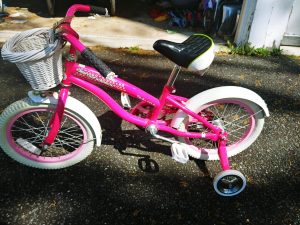Introduction
When it comes to cycling, the size of the wheels on a bicycle has been a topic of debate among enthusiasts and experts alike. One question that often arises is whether bigger wheels are easier to pedal than smaller ones. While there is no straightforward answer, this article aims to explore the relationship between wheel size and pedaling efficiency. We’ll examine the factors that come into play, the advantages and disadvantages of different wheel sizes, and ultimately, help you understand how wheel size can affect your cycling experience.
The Basics of Wheel Size
Before delving into the details, it’s essential to understand what wheel size refers to in the context of bicycles. Wheel size is typically measured by the diameter of the wheel, usually expressed in inches or millimeters. The two most common wheel sizes for adult bicycles are 26 inches and 29 inches, although variations exist, such as 27.5 inches or 700c, primarily found in road bikes.

Factors Affecting Pedaling Efficiency
Pedaling efficiency is influenced by various factors, and while wheel size plays a role, it’s not the sole determining factor. Let’s explore some of the key elements that impact how easy it is to pedal a bicycle:
1. Gear Ratio
One of the primary factors influencing pedaling ease is the gear ratio. The gear ratio is the relationship between the front chainring and the rear cog, which determines how many times the rear wheel rotates for each rotation of the pedals. Cyclists can adjust the gear ratio to match their fitness level, terrain, and desired pedaling cadence. Regardless of wheel size, a suitable gear ratio is essential for an efficient and comfortable ride.
2. Terrain
The type of terrain you ride on can significantly impact how easy or difficult it is to pedal, regardless of wheel size. On flat, smooth roads, larger wheels might have a slight advantage due to their ability to maintain momentum better. On the other hand, smaller wheels can be advantageous for technical trails or urban commuting, where maneuverability and acceleration are crucial.
3. Rolling Resistance
Rolling resistance is the force that resists the motion of the bicycle tires as they roll on the ground. The type and condition of the tires play a more significant role in rolling resistance than wheel size. High-quality tires with low rolling resistance can significantly improve pedaling efficiency, regardless of the wheel’s diameter.
4. Weight
The overall weight of the bicycle and the rider can impact how easy it is to pedal. While wheel size itself doesn’t affect weight, larger wheels might be slightly heavier than smaller ones, which could influence acceleration and climbing performance. However, advancements in materials and design have minimized the weight difference between various wheel sizes.

Advantages of Bigger Wheels
Now, let’s explore some of the advantages that come with opting for larger wheels:
1. Improved Momentum
Larger wheels have a greater circumference, meaning they cover more ground with each rotation. This characteristic can help maintain momentum, making it easier to pedal on flatter terrains, particularly at higher speeds. For the best ebike brands see here.
2. Better Rolling Over Obstacles
Bigger wheels tend to roll more smoothly over obstacles like rocks, roots, and potholes. This advantage is particularly beneficial for off-road cycling and mountain biking, where maintaining speed and stability are essential.
3. Smoother Ride
Due to their larger diameter, bigger wheels have a reduced angle of attack when encountering bumps on the road. As a result, they tend to roll over irregularities more smoothly, providing a more comfortable and less jarring ride.
4. Improved Traction
In certain conditions, larger wheels can offer enhanced traction. The larger contact patch allows for more rubber to grip the ground, which can be advantageous on loose or slippery surfaces.
Advantages of Smaller Wheels
On the other hand, smaller wheels have their own set of advantages that cater to specific cycling needs:
1. Increased Maneuverability
Smaller wheels have a shorter turning radius, making them more agile and easier to handle. This maneuverability is particularly valuable in tight spaces, urban environments, and technical off-road trails.
2. Quicker Acceleration
Smaller wheels are lighter and have less rotational inertia, resulting in faster acceleration from a standstill or when navigating through stop-and-go traffic.
3. Stiffer Wheel Strength
Shorter spokes and smaller rims can lead to increased stiffness, providing a more responsive and direct power transfer from the pedals to the road.
4. Lower Weight
Smaller wheels generally weigh less than larger ones, which can be advantageous for cyclists who prioritize climbing and want a lighter overall setup.
Conclusion
In conclusion, the question of whether bigger wheels are easier to pedal doesn’t have a simple answer. The ease of pedaling is influenced by a combination of factors, including gear ratio, terrain, rolling resistance, and rider weight. While larger wheels offer certain advantages such as improved momentum, better obstacle clearance, and a smoother ride, they may not necessarily be the best choice for all cyclists and terrains.
Smaller wheels, on the other hand, provide benefits in terms of maneuverability, quicker acceleration, and lighter weight, making them well-suited for certain riding styles and environments.
Ultimately, the ideal wheel size for you depends on your specific cycling preferences, the type of terrain you ride on, and your personal riding style. It’s essential to test ride bicycles with different wheel sizes and consider the other components and features of the bike to make an informed decision. Remember that comfort and enjoyment are equally crucial factors when choosing the right wheel size, so prioritize what suits you best and enhances your overall cycling experience. Are bigger wheels easier to pedal?




